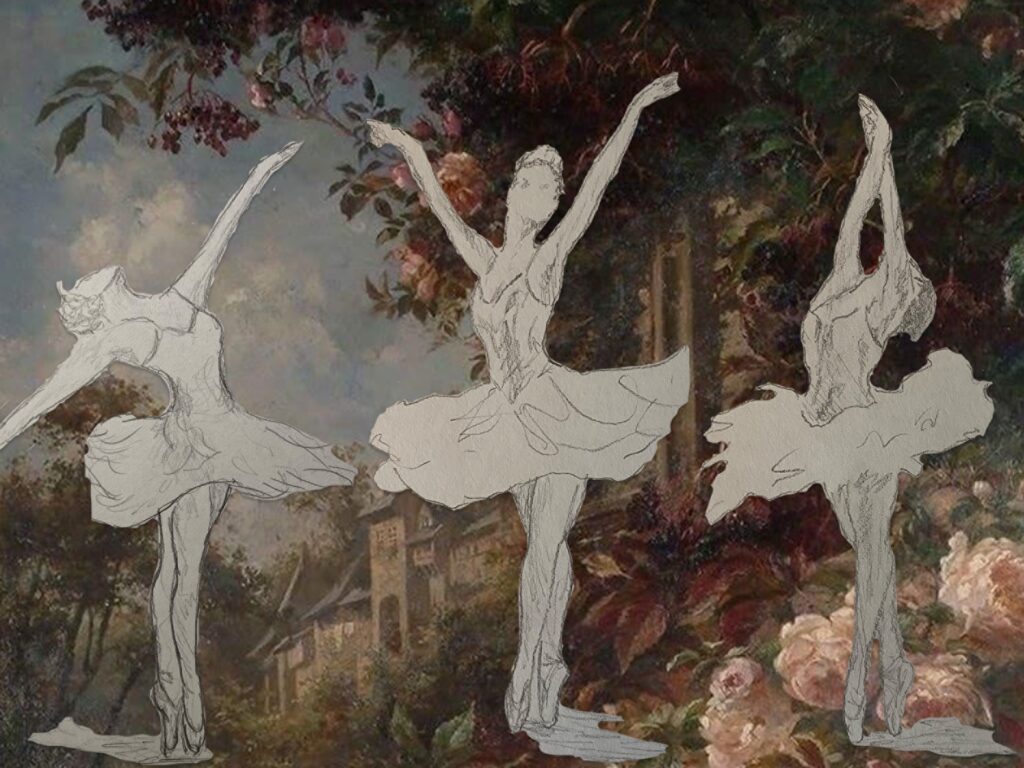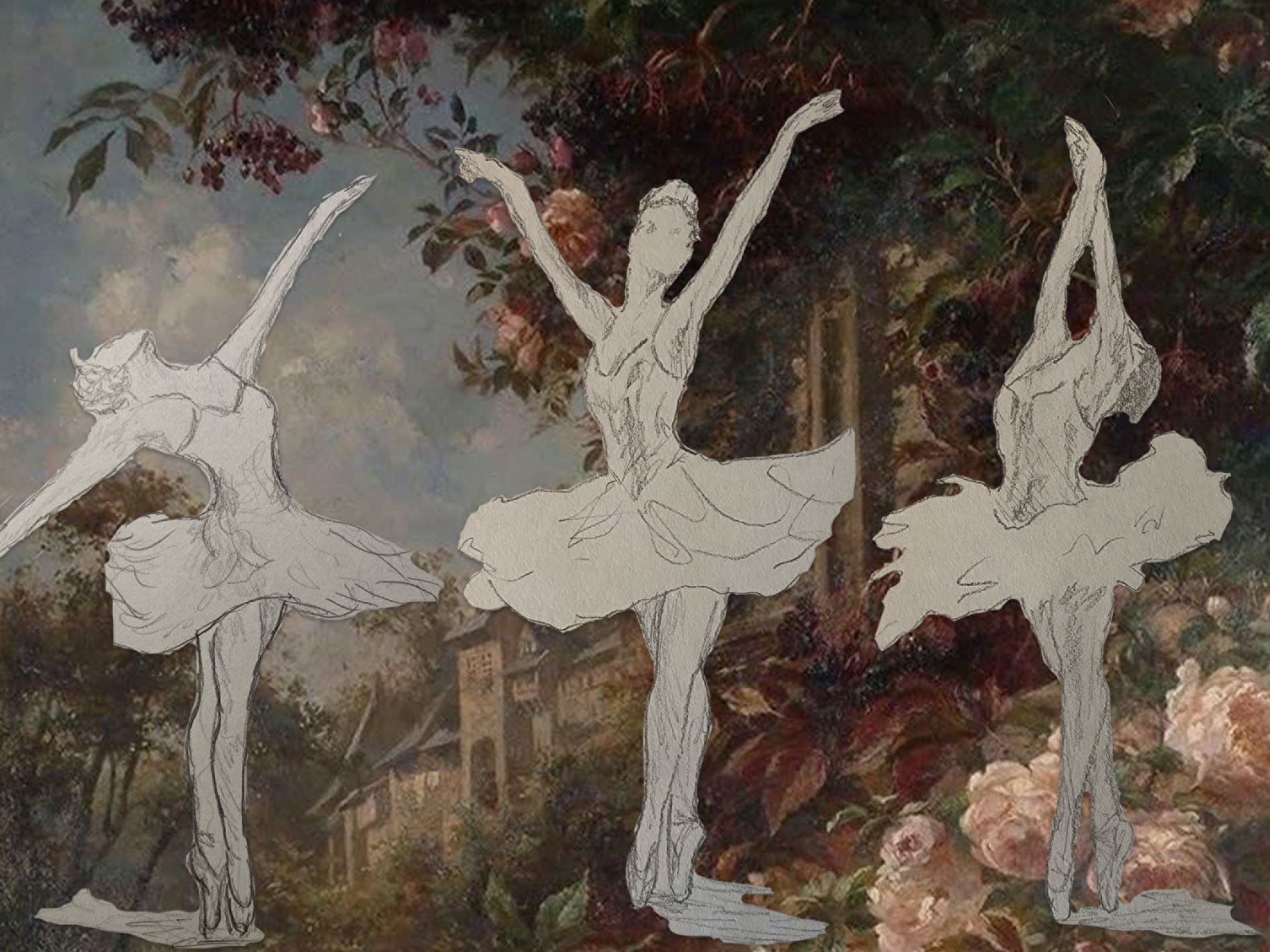How dance culture forces young women onto a path of perfectionism and disordered eating
BY CHIARA GRECO
ART BY ANTHONY GRECO
———————————————————–
Murphy McDermott stands with her dance team backstage. They are all in matching black outfits, fitted pants, and tank-tops. She and her teammates are crying—getting into character is what they call it. Thinking of their lives’ saddest moments in order to deliver a performance they’ll never forget. Today they are competing in Chicago, but in a few days the team will be travelling across the United States to perform elsewhere, at another competition, on a similar afternoon, in a dance hall that mimics this one. It’s McDermott’s senior year of high school, 2017, and she had been practicing this particular performance every Tuesday and Sunday with her team, adding up to a total of more than 40 hours of rehearsal. This is the moment they all are waiting for. This is the moment they have sacrificed themselves for.
In front of the stage sits an audience of nearly 400 strangers. A row of judges is propped up in the middle of the audience, pens in hand, ready to criticize their every move. Their dance teachers stand on the sidelines. The atmosphere in the room is heavy. McDermott, who is 17, begins by shaking out her hands, a nervous ritual she performs every time before she gets on stage. Her mind is racing through her list of insecurities, tears pooling in the corners of her eyes. She does her stretches. She takes her pre-show breaths. A deep exhale. She is ready.
Their dance number is announced through the overhead speakers. The performance is titled “Rescue.” The music begins. The team scurries on stage and takes their position, a quiet hush comes over the audience. The atmosphere of the room shifts. The tension dissipates once the lights shine on stage and, with it, so do McDermott’s anxieties and fears. In those few moments, everything disappears. “It is all a blur,” says McDermott, half laughing. And then it is over, in the span of just four minutes. The stage lights turn off, blackness engulfs the room, the team huddles together and cries again—this time because they feel fulfilled. Immediately, McDermott’s anxieties come back. “It’s not like the audience knows how much work and struggle we put in,” says McDermott. “Often dance is underappreciated—it’s a sport with no gain.”
McDermott was enrolled in dance as soon as she was able to walk. Since she was four years old, she considered herself a dancer. In fact, she cannot begin to imagine a life without dance— despite the fact that it has caused substantial damage to her body. “Sometimes I feel like it has ruined my life,” she says. “Other times I ask myself why I’m still doing this, and the only reason I have is because I love it.” She is 22 years old now. When she first started dance, she felt hopeful that this was the field she was meant to go into. These hopeful thoughts were soon clouded by unrealistic self-expectations, by what she was expected to give up. Most of the sacrifices dancers are expected to go through stem from physical expectations—the culture of dance is obsessed with creating a “perfect body.” But in creating this body, physical harm can be done.
“You do not need to be a size zero to become a dancer, but the culture surrounding dance tricks you into thinking you do.”
Many dancers just like McDermott go through sacrifice after sacrifice, receiving nothing but fleeting applause. Flowers are thrown, congratulations are given, and then it’s over. The effects of their sacrifices, though, those stay. Dancers give up their minds and bodies in pursuit of perfection—an elusive sense of success. But often the stress of perfection catches up to them and, for many, this takes the form of disordered eating. Like many competitive dancers, McDermott developed body dysmorphia and bulimia, all in pursuit of achieving the coveted but unrealistic and harmful ballet body. This body, which often defines your success in dance, wasn’t always so strived for, nor is it intrinsically related to a dancer’s skill. This body is a creation, and it perpetuates the lie that your weight and figure should make or break your success as a dancer. Yet still it persists.
The Balanchine Body
It’s no secret that our society puts an immense amount of pressure on physical appearances. We are often judged solely by the way we look, and there are certain beauty standards we feel we must live up to. But in the world of competitive dance, these pressures and standards are exacerbated. From diets to full-fledged eating disorders, the dance world breeds long-term body-image issues, all in the name of achieving some mythical perfection. But while the perfection is a myth, its repercussions are real. The culture surrounding dance has led many down a path towards a body that is encouraged, desperately strived for, despite the potentially dire consequences. You do not need to be a size zero to become a dancer, but the culture surrounding dance tricks you into thinking you do.
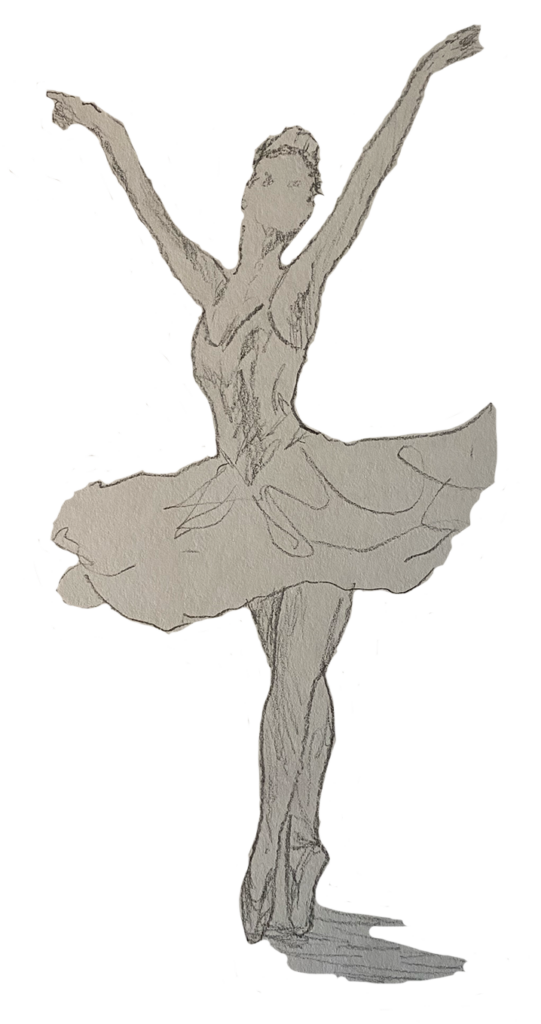
Nearly 12 per cent of dancers experience eating disorders, which primarily affect young girls and tend to materialize during the early teen years. A 2014 meta-analysis of studies from 16 different countries found that, for dancers, the risk of developing an eating disorder is more than 2.5 times that of the general population. It’s common for people with disordered eating habits to also experience body dysmorphia. All of the women in this story are representative of these numbers—a fraction of the people who have experienced the darker realities of ballet. The dance world is an intense field that requires strength and perseverance to get through it unscathed. I know this firsthand.
During our early development stages, body image is especially important because it affects our identity, mood, self-esteem, and behavior. At a young age, we are primed to be the best versions of ourselves. In the dance world, this “best version” is often dependent on physical ability: how well you can point your toe, how smooth your fouetté turn is, how precise your chaînés are… the list goes on. Ballet is so heavily focused on the outward self that the inward self suffers, leaving a lasting impact on mental and physical health.
“Nothing is off the table—from your hair to your toes, you question it all.”
In fact, the culture of ballet is so consumed with physical perfection that the term “ballet-body” was coined to describe the unachievable beauty standard that’s become normal in the dance world, the same standard that can lead to eating disorders and extreme dieting. The ballet-body is white, toned, muscular, thin, lean, curveless, and flat-chested. In simple terms, it is unrealistic, exclusionary, and, frankly, dangerous for most people. But this wasn’t always the case.
In the early nineteenth century, ballerinas were muscular with broad shoulders and sported larger thighs, arms and torsos than today’s dancers—their weight was commensurate with the muscle mass required to perform the physical feats of ballet. While it is hard to pin-point when this ideal body type changed, some research points to George Balanchine (1904–83). Known as the father of American ballet, Balanchine created more ballets than any other choreographer in the world—all with a specific and unrealistic type of dancer in mind. In Elizabeth Kiem’s article, “George Balanchine: The Human Cost of an Artistic Legacy,” Balanchine’s ideal body type for his dancers is described as tall, leggy, linear, and frighteningly skinny. All of Balanchine’s dancers were expected to conform to these standards and if they didn’t, they wouldn’t be cast in his performances. Balanchine liked his dancers hungry.
While the idea of the ballet body began as one man’s preference, it’s now the norm. It is troubling that this ideal body stuck around for so long, but unfortunately, it’s not surprising. And perhaps that’s the biggest problem. All of the women I have spoken to have suffered from eating disorders, and yet nothing they’ve said shocked me. It almost seems normal, or worse, it feels like it’s just part of the routine. When you talk about ballet, you’re really talking about hunger, thinness, starvation, perfection. For me, to say someone was a ballerina seems to really mean they, at one point, suffered from disordered eating. Saying, “she did ballet” is just a hushed way of saying she starved herself. It feels like a euphemism. The two feel ingrained in one another, and while it may not be all because of Balanchine, he is certainly part of the problem. But categorizing him as just a villain would be too simple.
Balanchine’s legacy extends far beyond beauty standards. He transformed ballet into a dignified art form. But, in doing so, he helped create the harmful aesthetics associated with the ballet-body and the ‘ideal woman.’ He crafted dancers to conform to his standard of beauty—a standard beyond body type. Young girls who are put into dance now are still subtly taught that these unrealistic standards, created by a man in the 1940s, are what is needed to achieve success as a dancer. While this is just not true, these unrealistic standards push many women to their ends.
Weighting for Success
Ballet and dance are not inherently negative. In fact, for many, dance can be cathartic, a way of letting out what’s inside, a way of expressing your sense of self. But often, ballet does not take the cathartic route. Instead, it is rigorous. Competitiveness and perfectionism are bred into the ballet world. Every single thing about you is picked apart. You are forced to compare yourself to others, to constantly question your abilities, your looks, your stamina, your body. Nothing is off the table—from your hair to your toes, you question it all.
During practices, McDermott would duct tape her thighs underneath her leotards to make herself appear thinner. She remembers that all the good dancers in her studio just “happened” to be skinny. If she wasn’t chosen to perform in the front row, she thought she wasn’t pretty enough. And it wasn’t always so subtle. Once, when a choreographer came into her dance camp practice and called out the beauty of some girls, McDermott was not among them. “Well, cool, I guess I’m not pretty then. You just take that stuff so personally, especially when you’re young,” McDermott says, rolling her eyes, remembering her tween self in that moment. At the time, she didn’t recognize the impact this was having because of how normalized it was. “I was not only comparing my movement to the other girls, but my body as well. I didn’t understand that we all have different body types, and I honestly don’t know that I can fully say I understand it now. Like why can’t I have the body that I want and not the body that I have?” In many ways, McDermott’s mental state is representative of the culture of ballet, a culture that forces people to think less of themselves.
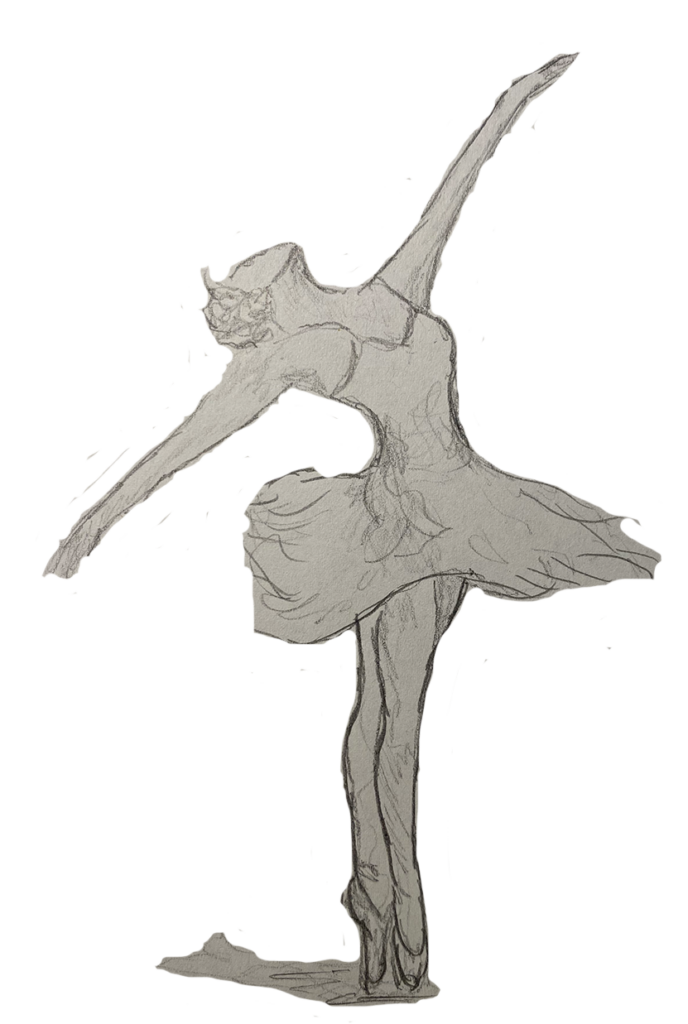
This culture encourages body surveillance, a phenomenon that occurs when people experience a heightened awareness of their bodies, and look at themselves from the observer’s perspective. Catherine Sabiston, a professor and research chair in physical activity and mental health at the University of Toronto, argues that body surveillance has an impact not only on self-esteem but also on our physical self. It encourages objectification and sexualization of one’s own body.
In dance, this happens at a young age. Sabiston says that body surveillance, coupled with the competitive nature of ballet, creates a recipe for disaster. Instead of feeling pride in their bodies, dancers come to feel guilt and shame, which builds up over time and often leads to the development of eating disorders, loss of menstruation, and stunted growth patterns—McDermott went through all of this. Sabiston says that pride is ultimately tied to accomplishments, and in dance, accomplishments are associated with what the body can do. Dancers should feel proud of themselves. Instead, constantly watching themselves in those daunting studio mirrors with next to nothing on, they come to feel shame and guilt. A 2006 study suggested that when female dancers are in a different setting—fully clothed and performing without a mirror or audience—they feel more pride. McDermott remembers being acutely aware of the way she looked when she was dancing. “Right around puberty we had to wear these costumes that were beige crop tops and shorts. And I started bawling my eyes out,” she says. “I did not want to go on stage.” On other days, she found herself backstage, hunched over a toilet bowl.
“Doctors told me, ‘You’re gonna die.’ I was like, ‘It’s okay.’”
— Murphy McDermott
For McDermott, disordered eating became a natural part of her life while in dance. At 15, McDermott’s dance teacher put her and her teammates on a fruit diet for three weeks straight. They were not allowed to eat anything else. Diets such as these are common practice for many dancers. “I felt like shit,” says McDermott, “but in my head this was just what athletes do. I felt like I was training for the Olympics.” McDermott saw her physical body change in ways beyond regular puberty-related shifts. After losing more than 20 pounds from bulimia, McDermott went to a doctor’s appointment for a regular routine check-up. “When I was at my skinniest, I didn’t have my periods and my potassium levels were fucked,” says McDermott, “Doctors told me, ‘You’re gonna die.’ I was like, ‘It’s okay.’”
But in the dance world, no one was taking it seriously. Other girls on her dance team were all quickly losing weight, too. But to each other they were never thin enough. “It was just the cycle of being a teenage girl,” she says. Before practice one day, McDermott was backstage vomiting into the studio’s toilet bowl when an insistent knocking at the door began. Her dance teacher had overheard her gagging and belching. She questioned McDermott, but ultimately brushed the situation off. The door was closed. She was told if she continued purging, she would be off the team. “I almost wanted pity,” she says. “I wanted someone to tell me you’re beautiful, you don’t need to do that.” But every time McDermott got a compliment about her weight loss she just fell deeper into her disorder. “Nobody ever asked if I was okay,” she says.
Disordered eating and ballet did not always go hand in hand. Sure, these types of behaviours are now ingrained in the culture, but at one time they weren’t. While it is tempting to place all the blame on Balanchine, he isn’t the sole culprit. It may be too broad to say society as a whole contributed to these issues and that the damned patriarchy is to blame, but that is also partly true. We have created unrealistic standards for all of us, and they can lead to dangerous physical and psychological side effects.
Starving For Perfection
Juliann Garisto describes her high school self as short, hairy, bracefaced, and awkward. Which is to say, she didn’t fit into the model standard that Balanchine, and our society, created for dancers. Garisto was enrolled in an art school in Toronto known for its respected creative programs. She was ecstatic when she got in. Before that she had only done recreational dance, so she had some experience, but not nearly as much as some of the other girls in the program who came from prestigious national dance schools. Her excitement soon turned to self-doubt. “The best dancers in my high school dance class were tall, beautiful, blonde, angelic apparitions,” says Garisto. “It was almost like they weren’t real.”
Garisto’s dance studio was filled with these girls. She struggled to overcome her own insecurities. At 14, she felt as if she wasn’t good enough to be a part of the studio. She wasn’t as strong or skinny. She was clumsy, filled with uncertainty, and always wanted to remain hidden. When she was asked to walk across the dance floor, she would feel nauseous. Not only did she lack the other girls’ technical training, she also did not look like them.
“These stories often don’t have happy endings.”
These feelings of doubt were almost textbook, and soon enough, Garisto had her first encounter with disordered eating. “My first encounter with a diet was secondhand,” Garisto says. She remembers seeing girls in her program who were so skinny that their bodies looked abnormally small, disproportionate to their heads. She remembers in the change rooms they would sit around and talk loudly about their food intake. They would say they were going to pass out, or hadn’t eaten all day, only took sips of Gatorade or ate a piece of cheese. “I just remember thinking like, holy shit, I’ve eaten more in the past 24 hours than these girls had eaten in the past three days probably.” In an attempt to become like them, she tried a raw diet. But it didn’t last too long. “I come from an Italian family that’s just like eat until you hate yourself,” says Garisto with a laugh. Though she was surrounded by dieting and thin girls, she could never get on board. Still, though, she struggled—how could she look like the other girls at her studio without starving herself? How could she become a real dancer without dieting? It seemed impossible. But it wouldn’t be until quitting dance entirely that Garisto developed her eating disorder.
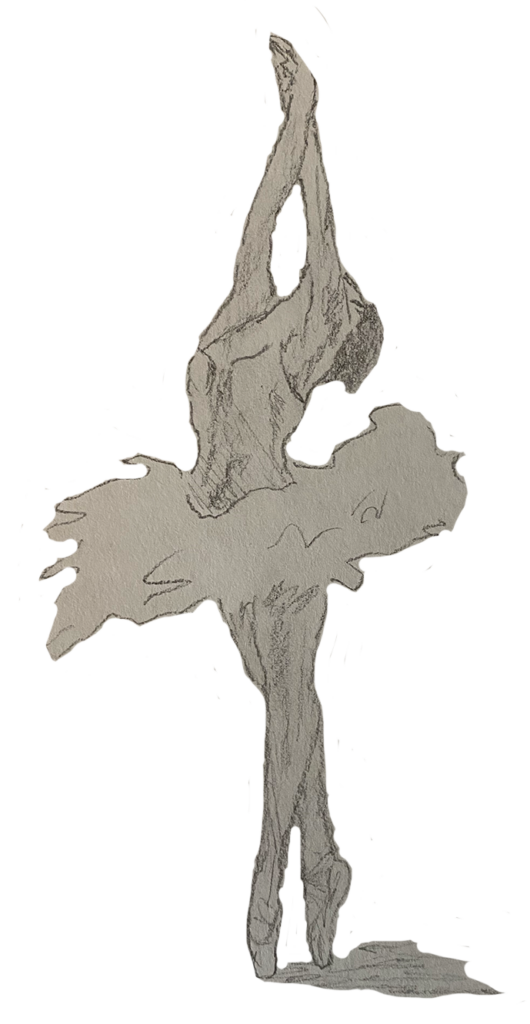
Two years after leaving dance, Garisto noticed her body changing as she got older and grew into herself. “When I stopped dancing, I wasn’t as fit anymore, or as light. So, I started to feel a sense of panic about that.” She tried to replicate the dance world through dieting and exercise, which ultimately led to disordered eating. But now, at 27, her relationship to dance is different than it once was. For her, dance was a challenge, it was something to overcome, to fight against, and despite it all, Garisto made it out alive. She escaped with her pride intact. But the physical and psychological damage that comes with an eating disorder followed Garisto throughout her life. Ballet should be an outlet for freedom. It should be a place of acceptance. But so long as we conform to the standards Balanchine and our society created, we may never reach acceptance.
Freedom
In a studio in Vaughan, Ontario, Madeline Corradi’s dance teacher calls for her to come to the front of the class. Her form is perfect. It is a jazz class. Corradi is nine. She feels empowered by her differences. She feels acceptance—in this story she is an anomaly. In fact, it wasn’t until quitting dance that she became aware of her body. Standing in front of her class, her teacher asks her to perform. She closes her eyes and gets into position. She does not feel nervous at this moment. Her movement is fluid, her body is doing what it is supposed to. Her face can’t even begin to hide her excitement. Her teacher looks at her with a smile. Everyone claps. “Dance gave me freedom and a lot of confidence. Even though I had a different body, I never really thought about it,” says Corradi. This was just four years before she would quit dance, and six years before she would take up a rigid diet and exercise routine. But while in dance, Corradi thrived. She was 12 years old when she was picked for a solo. She was dancing to a Jason Mraz song. The stage was hot and bright. She was scared, but comfortable. The bright lights from the stage were so blinding that she could barely make out the audience or judges. She felt like she was alone. She had on stretchy jeans, a white blazer and a pink satin sequined hand-me-down corset. Her hair was slicked back into a bun with a pink flower clip. She was performing a tap number, her favourite. “I had a looseness that a lot of the other girls didn’t,” says Corradi. She felt comfortable in herself. It was the first time she was truly proud.
According to research from the International Journal of Eating Disorders, while eating disorders and body dysmorphia cannot be purely attributed to the environment, one’s surroundings can act as a catalyst. Though Corradi was a competitive dancer, she never viewed herself as being in competition with other dancers—she did not take the perspective of the onlooker. Her self-image was not tainted by the notion of achieving the coveted ballet body. Instead, her shame and guilt built up over time. In the years after she quit dancing, a quick weight gain sparked disordered eating habits. It also led her to take up running and hockey in place of ballet as a way to try and lose weight. Still, Corradi, who is 23 now, looks back on her experience with fondness. After our conversation she says, “I love talking about dance. I forget, it’s like a whole lifetime ago. I was a different person back then.”
New Beginnings
When I think back to my own experience with ballet, I feel grateful. But I know not many can say the same. McDermott still looks for ways to continue dancing. After all, she doesn’t know another way of life. Garisto and Corradi each left ballet as a different person. These stories often don’t have happy endings. Recovery doesn’t always end with clear-cut happiness or solutions, but the women I spoke to can at least look back on their moments in dance with more ease, more understanding, and more sympathy for the girls they once were. Still, they all call for change, because for most of these women, issues of body dysmorphia and disordered eating didn’t end once they hung up their dance shoes—the physical effects followed them.
I’d like to imagine that somewhere young girls are no longer feeling controlled by ballet. That it instead is a place of solace. While I’m fairly certain this ‘somewhere’ does not yet exist, I’m sure it could. Ballet requires a transformation, a transformation that removes the body from the art. It should represent not sacrifice, self-doubt, and self-hatred, but instead, growth. It should be a place that feels like home. If Balanchine never existed, maybe all the issues with dance would have never come to be. This may be wishful thinking. One thing I am certain of is that there are hundreds more stories to be told about ballet’s harm. That alone should be the reason for change.
